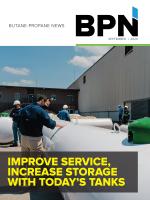Thursday, September 3, 2020
Using propane in fuel cells, developing commercial applications for lowering NOx and particulate matter (PM) emissions, creating combined heat and power (CHP) solutions for residential applications, promoting propane as a marine fuel to lower carbon emissions in the world’s waterways, and enacting carbon capture processes to eliminate carbon dioxide. These are all subjects Dr. Gokul Vishwanathan has either studied or worked on to develop real-life solutions. They are all areas of interest as the Propane Education & Research Council (PERC) plots its 2020-22 Strategic Plan. Vishwanathan recently joined PERC as director of research and sustainability. 
“We’re happy to bring Gokul on board,” said Cinch Munson, PERC’s senior vice president, business development. “His experience really fits our strategic priorities and what we need to accomplish. Renewable propane, on-road and off-road applications, engine growth opportunities, energy storage, fuel cells, and carbon capture are all key areas we are focused on and Gokul has experience with all of them. He comes in with relationships already built with a lot of experts, and those relationships are very important.” Vishwanathan, a mechanical engineer, joined PERC on May 18 and leads PERC initiatives to grow propane demand through research, technology development, and sustainability programs. He received a master’s degree in mechanical engineering from the University of Alabama and a Ph.D. in mechanical engineering from the University of Wisconsin—Madison.
EXPANSIVE DOE EXPERIENCE
Prior to joining PERC, Vishwanathan worked for Booz Allen Hamilton, where he supported the U.S. Department of Energy’s (DOE) Advanced Research Projects Agency-Energy (ARPA-E) and the Advanced Manufacturing Office (AMO) of the Energy Efficiency and Renewable Energy (EERE) agency as a technical advisor and subject matter expert in connected and automated vehicles, powertrain development including both conventional reciprocating engines and hybrid electric vehicles, CHP, thermal energy storage, and carbon capture technology.
He was a technical specialist at Cummins heading medium-duty and heavy-duty diesel engine development work and advancing novel fuel and air-path calibration mechanisms for diesel engines.
“During the time I worked for the Department Of Energy (DOE), I worked on various programs focusing on the development of internal combustion engines, hybrid-electric vehicles, thermal energy storage, and carbon capture solutions,” Vishwanathan said. “At Cummins, I spent three and a half years doing diesel engine development work.” Discussing carbon capture, he described it as a process of capturing carbon dioxide emissions, usually from large sources, such as a cement factory or a powerplant, and transporting it to a site and depositing it where it will not enter the atmosphere.
PREVIOUS CONTACT WITH PERC
In the process of working at DOE, Vishwanathan came to know Greg Kerr, who was PERC’s director of research and development at the time, and through some mutual projects, he learned about PERC and some of its efforts to generate new uses for propane. “PERC has been looking at a lot of new uses for propane that will increase demand. The role of director of research and sustainability piqued my interest.”
“I don’t believe propane is just a ‘bridge fuel,’” Vishwanathan explained. “It has so many ways it can be a long-term solution. In its liquid state, it stores very well versus other gases. It has a low carbon-to-hydrogen ratio, which means less carbon footprint. It is non-toxic and when combusted, leads to low NOx and PM emissions.” He believes there will be some amount of electrification in vehicles in the future, but that propane will be involved in many hybrid electric vehicles. He thinks that lower emissions and less PM will continue to make propane a great solution for Class 3 to Class 7 vehicles; he sees tremendous potential in the lower end of Class 8 vehicles as well. He noted “Fuel cells are a potential solution for the heavy-duty truck market as well.”
“I think we have an unprecedented situation with COVID-19,” he commented. “Unfortunately, it has impacted our livelihood and it will take some time for our economy to bounce back. But it makes the need for cost-effective propane solutions more critical to provide benefits for many years to come. Electricity and propane will both have its place and they both will be in our palette of solutions. With electrification, the problem of carbon emissions is not yet resolved.”
Working closely with the National Propane Gas Association (NPGA) as well as all propane state associations and other industry stakeholders, Munson noted that PERC has developed data-driven, provocative, assertive messaging about new opportunities for propane. “We have to be competitive when talking about propane in the overall energy portfolio,” Munson said. “PERC has to be engaged with a variety of private and public organizations. It is important that we are involved with these players in the energy field, and I’m glad Gokul is also representing us in the energy conversation. Relationships are important.” — Pat Thornton

“We’re happy to bring Gokul on board,” said Cinch Munson, PERC’s senior vice president, business development. “His experience really fits our strategic priorities and what we need to accomplish. Renewable propane, on-road and off-road applications, engine growth opportunities, energy storage, fuel cells, and carbon capture are all key areas we are focused on and Gokul has experience with all of them. He comes in with relationships already built with a lot of experts, and those relationships are very important.” Vishwanathan, a mechanical engineer, joined PERC on May 18 and leads PERC initiatives to grow propane demand through research, technology development, and sustainability programs. He received a master’s degree in mechanical engineering from the University of Alabama and a Ph.D. in mechanical engineering from the University of Wisconsin—Madison.
EXPANSIVE DOE EXPERIENCE
Prior to joining PERC, Vishwanathan worked for Booz Allen Hamilton, where he supported the U.S. Department of Energy’s (DOE) Advanced Research Projects Agency-Energy (ARPA-E) and the Advanced Manufacturing Office (AMO) of the Energy Efficiency and Renewable Energy (EERE) agency as a technical advisor and subject matter expert in connected and automated vehicles, powertrain development including both conventional reciprocating engines and hybrid electric vehicles, CHP, thermal energy storage, and carbon capture technology.
He was a technical specialist at Cummins heading medium-duty and heavy-duty diesel engine development work and advancing novel fuel and air-path calibration mechanisms for diesel engines.
“During the time I worked for the Department Of Energy (DOE), I worked on various programs focusing on the development of internal combustion engines, hybrid-electric vehicles, thermal energy storage, and carbon capture solutions,” Vishwanathan said. “At Cummins, I spent three and a half years doing diesel engine development work.” Discussing carbon capture, he described it as a process of capturing carbon dioxide emissions, usually from large sources, such as a cement factory or a powerplant, and transporting it to a site and depositing it where it will not enter the atmosphere.
PREVIOUS CONTACT WITH PERC
In the process of working at DOE, Vishwanathan came to know Greg Kerr, who was PERC’s director of research and development at the time, and through some mutual projects, he learned about PERC and some of its efforts to generate new uses for propane. “PERC has been looking at a lot of new uses for propane that will increase demand. The role of director of research and sustainability piqued my interest.”
“I don’t believe propane is just a ‘bridge fuel,’” Vishwanathan explained. “It has so many ways it can be a long-term solution. In its liquid state, it stores very well versus other gases. It has a low carbon-to-hydrogen ratio, which means less carbon footprint. It is non-toxic and when combusted, leads to low NOx and PM emissions.” He believes there will be some amount of electrification in vehicles in the future, but that propane will be involved in many hybrid electric vehicles. He thinks that lower emissions and less PM will continue to make propane a great solution for Class 3 to Class 7 vehicles; he sees tremendous potential in the lower end of Class 8 vehicles as well. He noted “Fuel cells are a potential solution for the heavy-duty truck market as well.”
“I think we have an unprecedented situation with COVID-19,” he commented. “Unfortunately, it has impacted our livelihood and it will take some time for our economy to bounce back. But it makes the need for cost-effective propane solutions more critical to provide benefits for many years to come. Electricity and propane will both have its place and they both will be in our palette of solutions. With electrification, the problem of carbon emissions is not yet resolved.”
Working closely with the National Propane Gas Association (NPGA) as well as all propane state associations and other industry stakeholders, Munson noted that PERC has developed data-driven, provocative, assertive messaging about new opportunities for propane. “We have to be competitive when talking about propane in the overall energy portfolio,” Munson said. “PERC has to be engaged with a variety of private and public organizations. It is important that we are involved with these players in the energy field, and I’m glad Gokul is also representing us in the energy conversation. Relationships are important.” — Pat Thornton


